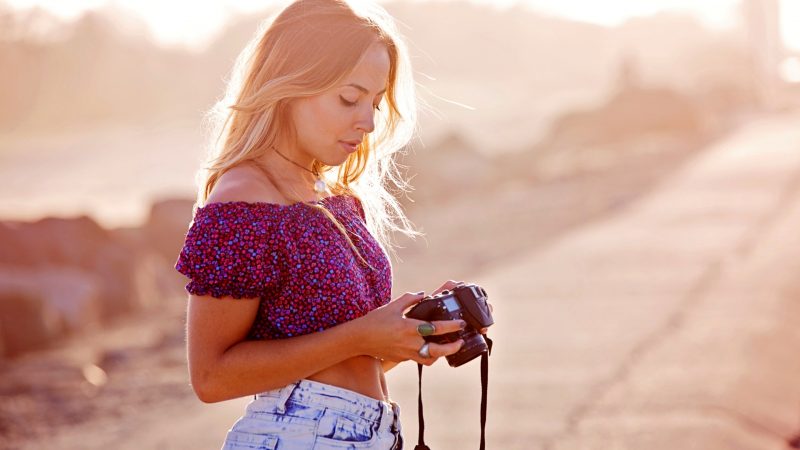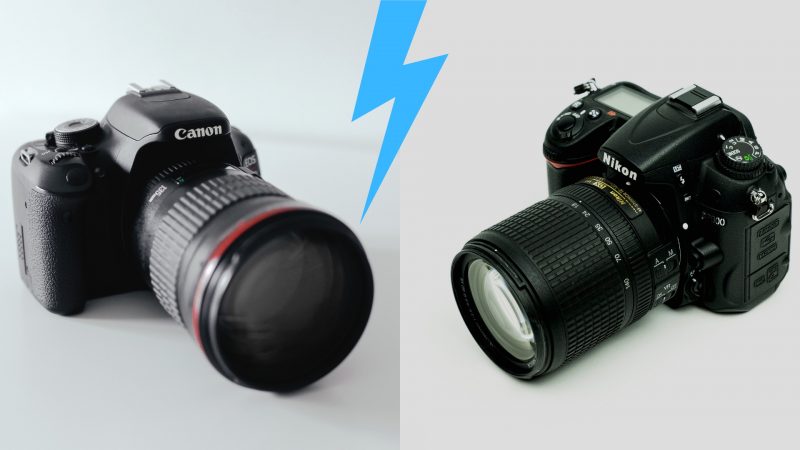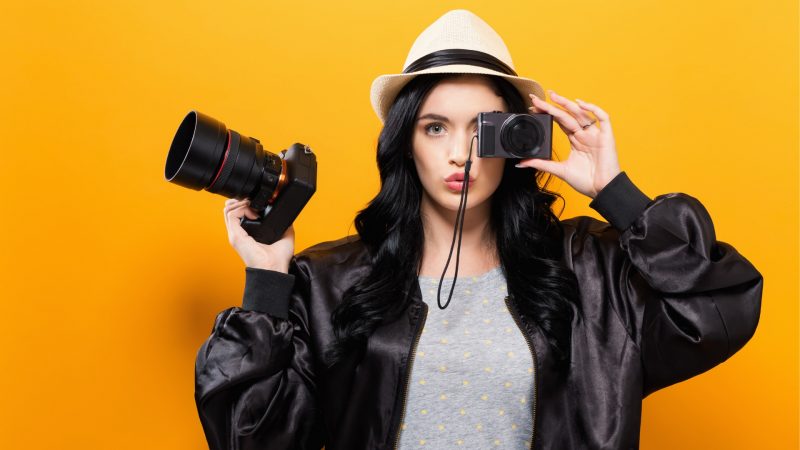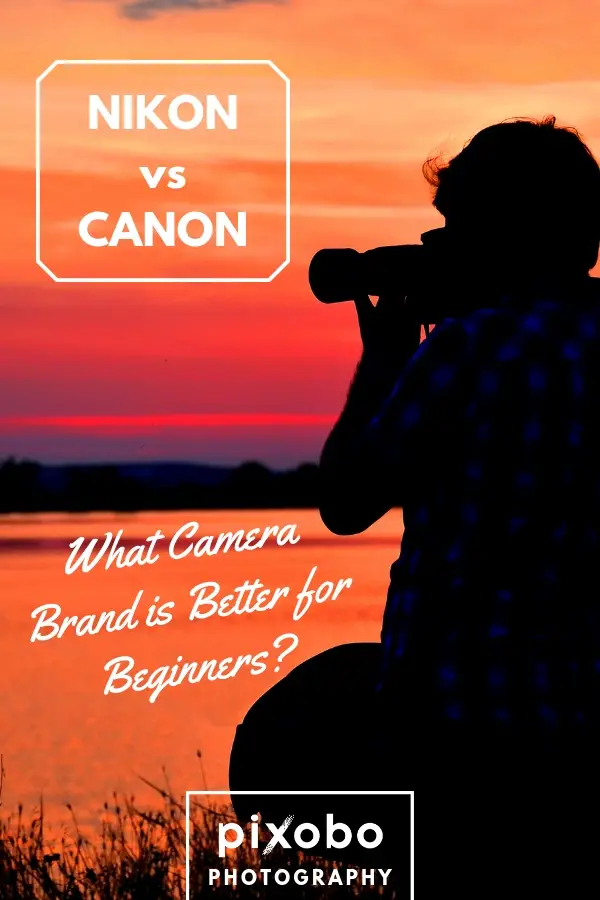Are you passionate about taking beautiful pictures? Do you catch yourself looking through photos and imagining how to recreate them? If the answer to any of these questions is yes, you might be ready for a career in photography.
A DSLR camera stands for a digital single-lens reflex camera. In its body, you can find a mirror. The mirror’s job is to reflect light that comes from the lens into an optical viewfinder. Light in higher-end DSLRs is reflected in a prism-like shape, while in lower quality ones the light bounces around a series of mirrors. The view is translated into understandable information: which is what you see when you’re shooting.

However, photography is an expensive lifestyle, so it’s vital to be sure of your equipment choices (especially if you prioritize your gear). After purchasing a DSLR camera, you can only use the lenses and flashes that fit your particular brand. After that engagement, it’s usually costly to replace your entire kit with a new one.
Table of Content
Is Canon or Nikon Better for Beginners?
In most cases, Nikon is better for beginners. Its settings and terminology are easier to understand. Budget wise, Nikon offers better beginner cameras for a lower price. However, most enthusiasts would be happy with a camera from either brand.
Some older model Canon DSLRs cost around 500$ (USD), but newer ones start at 900$, we are talking about just the body of the camera. Contrarily, you can get the Nikon D3500 with amazing DSLR quality performance with a lens kit also for just 500$. Some enthusiast cameras have similar costs, but many times Canon lacks compared to Nikon. Let’s examine the Nikon D7200 and the Canon T6S.
The Nikon D7200 doesn’t have a low pass optical filter. It has autofocus with 51 points, HD video at 60 fps, 7 fps burst, and battery for up to 1100 shots. Canon’s T6S has similar stats but with a lower number of autofocus points – 19, it does has a low pass optical filter. It can take videos at 30 fps HD and the burst is at 5 fps max. Also, its battery lasts half the time.

The optical viewfinder of a DSLR uses very little power. Consequently, this type of camera usually has a long battery life, especially in higher-end models. Beginner models, like Canon’s EOS Rebel T7i, typically work for about 600 shots, while more advanced models, like Nikon’s 45-megapixel D850, stay alive for more than 1,000 shots.
When it comes to professional photography, Nikon and Canon are amazing cameras with good image quality and loads of accessories. Higher class cameras are incredibly similar. They still have some variations, but choosing which camera is better is mostly based on personal preference.
Budget wise, it’s better to buy your first DSLR as a kit: which is composed of the camera body and an 18-55mm lens. Usually called kit lenses, they’re known for having a broad zoom range, enabling the photographer to capture both landscapes and portraits quite nicely.
You may notice that manufacturers will create lenses with or without image stabilization. Those with stabilization shoot sharper images at slower shutter speeds. Many recommend them, especially since both are priced similarly.
Related: Best Entry-Level DSLR Cameras in 2019
Canon vs. Nikon

1. Operation
Both cameras perform similarly. However, the two companies use different words or markings for the same functions. Also, Nikon usually has longer battery life.
2. Sensors
Canon and Nikon have similarly sized sensors. When one manufacturer improves its technology, the other catches up.
3. Speed
Less expensive models, beginner Nikons are usually faster than Canons; however, the difference is typically only of one or two frames. A good comparison would be the Nikon D7200’s six to seven fps and the Canon T6S’s five fps. Canon’s more professional models are usually faster, like the EOS 7D Mark II with ten fps: which is excellent for sports.
4. Video Quality
Canon cameras were the first that could refocus while recording a video using a hybrid autofocus system, and they’re known for their stabler autofocus tracking while filming. Canon offers a variety of lenses made specifically for video. However, thanks to technological advancements, Nikon is catching up (and vice versa).
Professional vs. Non-Professional Digital Cameras
1. Professional

Today, the majority of professional cameras are large and heavy DSLRs; but the bridge and mirrorless cameras are also gaining popularity among users. Most high-end models have a full-frame sensor. To save money, many manufacturers make DSLRs with cropped lenses: which makes their cameras more accessible to users. Different types of sensors influence the behavior of the camera’s lenses. Most brands sell cheaper lines of interchangeable lenses for beginners and more expensive lines for professionals.
Compact mirrorless cameras are a high-quality, small, and light option that gives you a lot of control over your photos. These cameras can take amazing, high-resolution photographs, and they cost less than most DSLRs. They lack an internal mirror that reflects light: meaning that light goes directly from the lens to the sensor. The majority of mirrorless cameras are composed of interchangeable lenses, many features for creative control, facial recognition, focus points in the whole frame, high resolution, video, and wifi capability. Many professionals are buying them as a new alternative, or as a travel camera.
An extra advantage of DSLRs and a mirrorless camera over the point-and-shoot cameras is that you can look through the optical viewfinder and see what you’re capturing before you click the photo. Compact cameras may have some lag because the sensor has to translate its information to an unrelated screen in the camera. A disadvantage of DSLRs is that you can’t preview your exposure via the optical viewfinder: which is something you can do with a mirrorless camera.
Medium format cameras are special, mostly because they offer a bigger sensor than a full-frame DSLR. Thanks to their fantastic resolution, these cameras are used for high-quality photography and advertisements. On the downside, they’re not as advanced in autofocusing systems and burst modes: meaning that they’re not the best fit for every type of photo. Also, their price is extravagant (the Hasselblad H6D-400c costs 50,000$ for just the body): therefore, even professionals prefer to rent rather than buy.
2. Non-Professional – Compact Cameras

A compact camera is a relatively inexpensive, beginner camera made for amateur photographers. They’re small and usually composed of standard, automatic settings: which makes them one of the most user-friendly options. Also known as point-and-shoot cameras, once you frame your subject, the camera determines the correct exposure. They have a built-in flash, zoom lens, LCD screen, and (sometimes) manual functions. The device does all the work, but its pictures are less professional.
Zoom compact cameras have a more advanced zoom lens: meaning a greater magnification capacity ranging from 28-300mm at a minimum of 12 megapixels. They don’t have interchangeable lenses because of their zooming ability. However, they all have automatic exposure options, and some even offer manual settings and HD video recording. Still, these cameras are unfit for professional use.
Advanced compact cameras are small, light-weight devices made for more experienced learners. They let you manually set exposure mode and focus, giving you more control than a regular compact camera while staying user-friendly.
Action cameras are weatherproof and shockproof, with lenses protected by a remarkably durable glass. In spite of their small size, they’re highly versatile and have high resolution. Thanks to these qualities, they’re gaining popularity, and new models are popping up everywhere. On the downside, their sensor is small, and their lenses are not interchangeable.
How to Determine What You Need?

When deciding which to buy, ask yourself the following questions:
- What’s the most important quality your camera should have?
- Which camera is better suited for your experience level and budget?
- What sort of upgrades can you make to this camera within the next few years?
- What lenses do you want to use?
- Does your manufacturer produce these lenses?
Ideally, you shouldn’t have to spend a heap of cash for the right camera. However, don’t try to save money on things you need to succeed. Still, keep in mind that many expensive models come with features that you won’t necessarily use right away, but may enable you to grow and learn in the future if you plan to pursue a career in photography.
Cheaping out may get you a camera whose features and capabilities are insufficient for your needs. Because of recent advancements in phone cameras, sometimes you won’t even need an entry-level camera or a point-and-shoot (unless it’s for a distinct reason). If picture quality is important to you, but you’d also like to save money, plan to spend a minimum of 500$ on your beginners DSLR.
You can pay less if you want something slightly better than your phone. However, keep in mind that skill and creativity are the most important qualities a good photographer should have, and an expensive camera won’t make you better.
If you want to see our recommended cameras for beginners or professionals go to our recommended photography gear section. We made a detailed review of the best cameras for every photographer. Hope we can help you make your decision. Feel free to comment and ask for our help!
Related: How To Choose The Best Camera For Your Needs – 7 Step Guide

